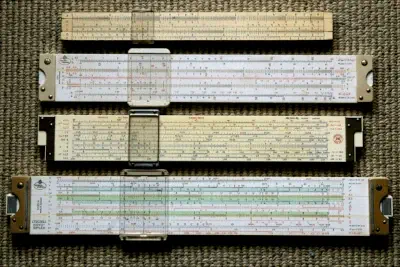
Many people would consider a sliderule to be quaint and obsolete technology, but you never have to replace the batteries in a sliderule or to hold it under a bright light to recharge the battery. And there is a certain satisfaction in cranking out (or sliding out) an answer that is accurate to 3 or perhaps even 4 significant digits, while your buddy is still frantically pressing keys on his fancy calculator or phone.
I have a small collection of sliderules, nothing special, just ones that I have been given or purchased to use over the years. This article is about my four favourite sliderules.
Keuffel & Esser N4058W
The K&E N4058W was my first sliderule, given to me by my parents when I was in Grade 7 or 8. It is the same model that my father used at that time in his work in electronics. Thanks to my father, I already knew a bit about logarithms so learning to use a sliderule was easy. This sliderule is made of wood and was called a beginner's sliderule, having scales A [B CI C] D K and on the reverse side of the slider S L T, all that I ever needed in those days. It still works well although now it is a little more stiff than it used to be.

Faber-Castell 2/82
I bought this Faber-Castell Biplex Log Log 2/82 new to attend college in
1960. It served me well there and then through 3 years of employment in electronics,
and then 3 more years at university. Although it is now more than 60 years old, the action
is still very smooth and it is very nice to use. It is a very versatile
sliderule. On the front are scales :
T1 T2 A [B BI CI C] D P S
and on the reverse are scales :
LL03 LL02 LL01 K [K' L ST CF] DF LL1 LL2 LL3.
These scales are all pretty usual. To some people the K and K' combination might seem a little unusual but there are advantages to being able to calculate cubes from both the stationary body and sliding parts. The P scale is of course √(1-(0.1x)2).
I still have the original instruction manual for it.

Hughes-Owens Versalog
This Hughes-Owens Versalog was made by Hemmi in Japan and branded
Hughes-Owens. It was purchased new in 1970 by my employer after I complained
of having to carry my own sliderule (the F-C 2/82 above) back and forth between work
and home. When I retired many years later, my employer gave it to me as a
gift. It is a log-log sliderule with scales :
LL0 LL/0 K DF [CF CIF CI C] D R1 R2 L
and on the reverse :
LL/1 LL/2 LL/3 [T/T SecT/ST Cos/S C] D LL3 LL2 LL1.
Again, notice the lack of A and B scales. However, the R1 and R2 scales are the square roots of D and 10D.
This sliderule, too, is still very smooth to operate and nice to use. The instruction book, with exercises and answers, is worth studying for the use of any sliderule.

Faber-Castell Novo Biplex 2/83N
This Faber-Castell Novo-Biplex 2/83N is a very nice, very powerful and
versatile sliderule. I purchased it (used condition) a few years ago because
of its many advantages in use. Besides the many scales for different mathematical
functions and relationships, and the scales in two different colours for better
readability (red and black, as with some other sliderules), this sliderule has a few
scales with light shading (green) to make them even more distinguishable. Another
advantage is that the rule has a thin rubber strip at each end to support it so that the sliderule can
be used flat on a table surface, for example, to provide added stability and steadiness
in use. It has many scales, 30 in all :
T1 T2 K A DF [CF B CIF CI C] D DI S ST P
and on the reverse :
LL03 LL02 LL01 LL00 W2 [W2' CI L C W1'] W1 D/LL0 LL1 LL2 LL3.
Note that this sliderule has both the A and B scales (x2) as well as W1 and W2 scales (√x and √10x).
Unfortunately, I do not have the instruction manual for it, but that is not a problem for any experienced user.

I strongly suspect that the power and versatility of this wonderful sliderule was lost on its original owner because he had to write "cheat" notes on the inside of the closing flap of the leather case, about how to multiply and divide and how to find squares, square roots, sine, and tangent! Oh, well ...
Other Sliderules
I have some others, including a few "pocket" sliderules (generally about 15 cm in length) that I have used at work or while travelling, but of course these are not as accurate at the standard 25 and 30 cm sliderules.
Interested in Sliderules?
Any one who has used or still uses a sliderule or who collects them might be interested in the very active Sliderule Discussion Group at Groups.io.
As well, joining the Oughtred Society will provide a lot of information about the origins, historical and technical development, and many uses of the sliderule. The Society's broadly based international membership includes many experts and very knowledgeable collectors.
Note about Spelling
Throughout, I have spelled "sliderule" as one word, while others spell it as two ("slide rule"). My reason for this is that, as a tool, a sliderule is a singular object and deserves to be spelled as one word, just like "screwdriver". If spelled as two words, it is just a noun preceded by an adjective, like "short ladder". Having used one for too many years, to me it is a sliderule and I have spelled it thus.

